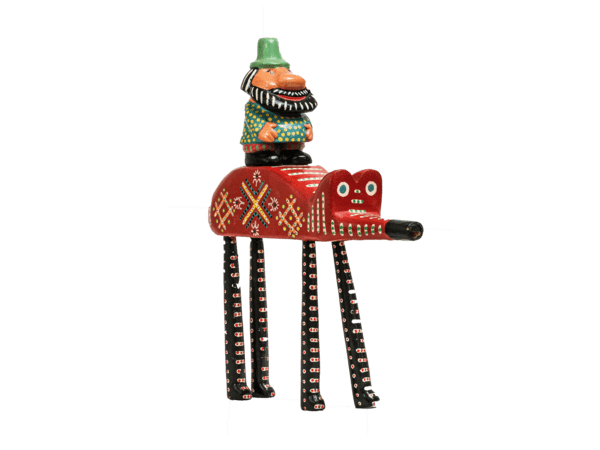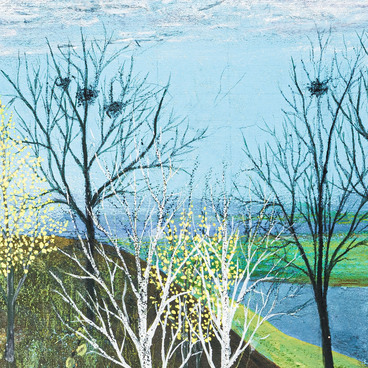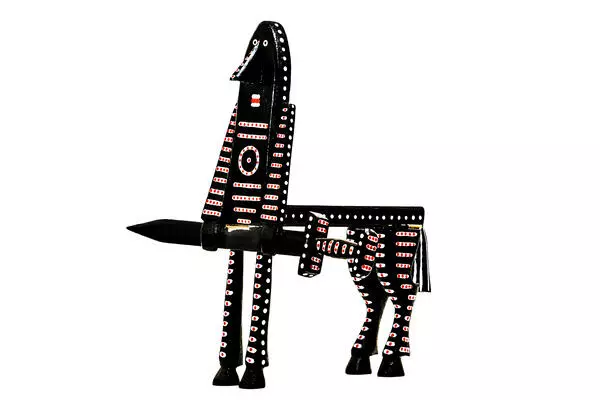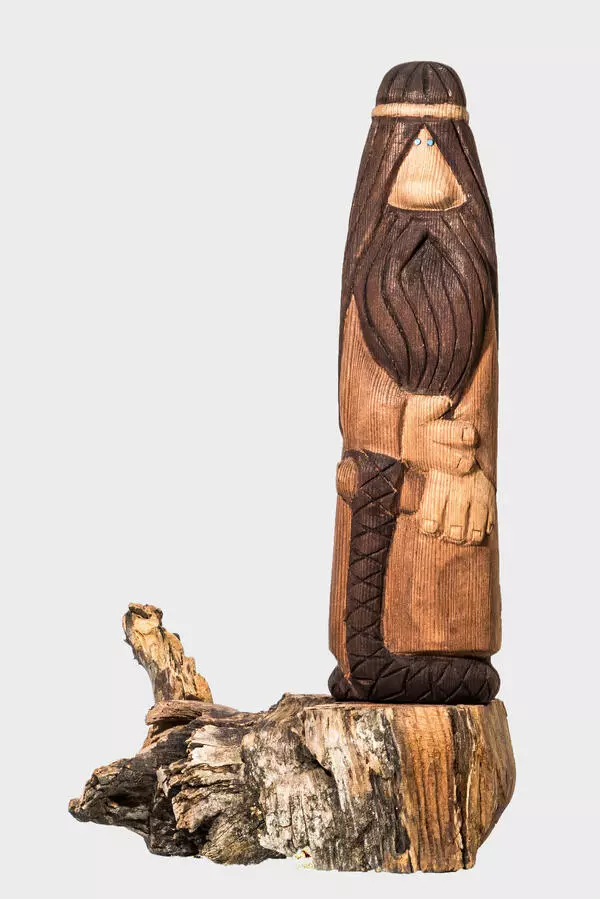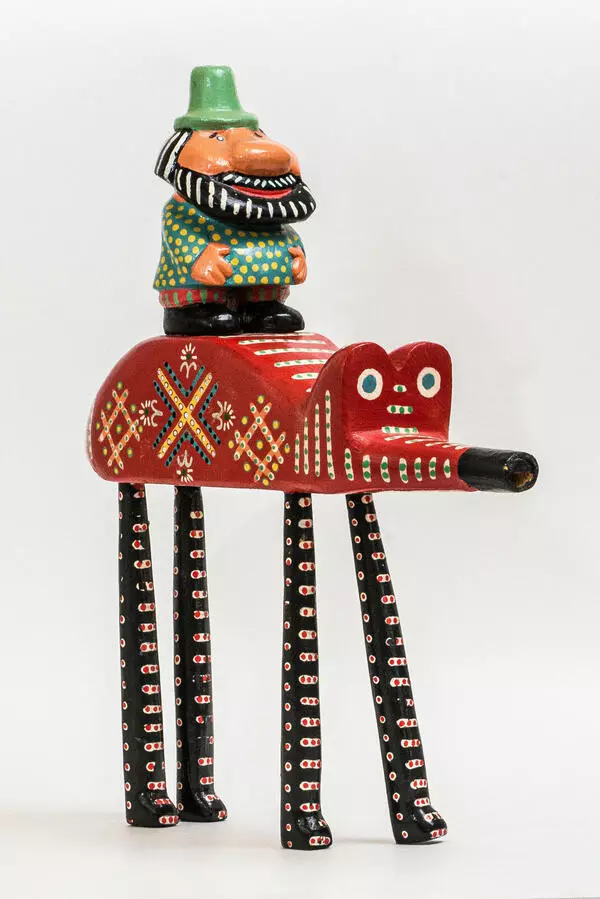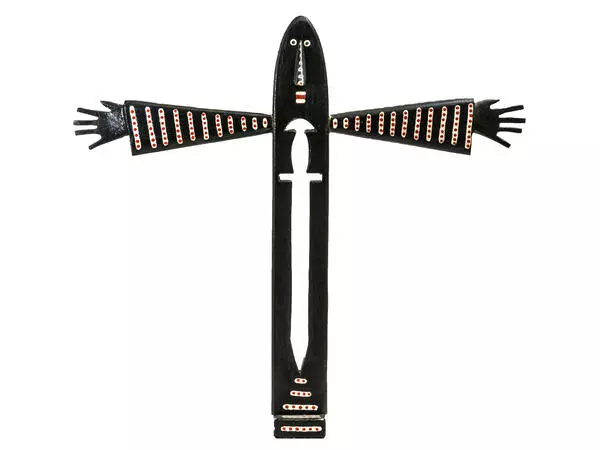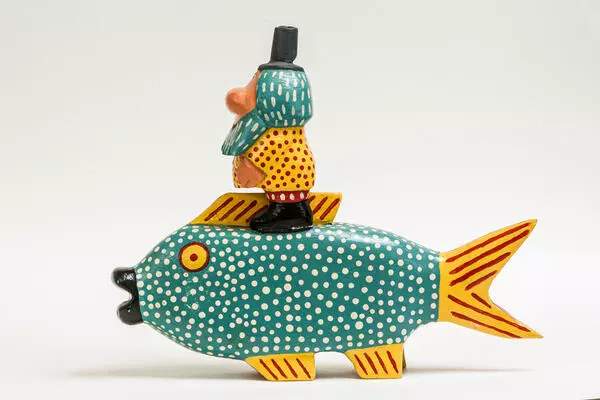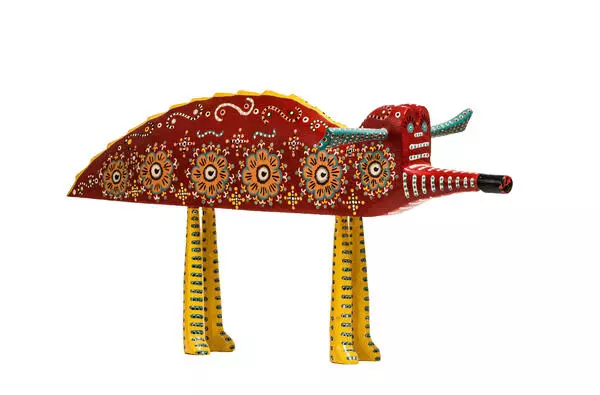#1
Nikolai Zykov
Male Water Spirit on the Fish, Crocodile (Whangdoodle), Household Spirit on the Whangdoodle, Polkan
#4
#8
Nikolai Zykov
Male Water Spirit on the Fish
#12
One of the largest collections of toys in Russia by the sculptor Nikolai Zykov is housed in the funds of the ‘Gamayun’ Museum Center. His works are presented in many museums in Yekaterinburg, they can be found in Sergiev Posad, Suzdal and Moscow, as well as in the Museum of Man — the anthropological branch of the National Museum of Natural History in Paris.
The work of Nikolai Zykov was based on Slavic mythology and traditions of Russian folk toys. The craftsman did not copy the works of other artists, but redesigned archetypal images. To keep them recognizable, he used traditional motives, lines and decor details typical of the Kargopol and Romanov folk toys.
The composition ‘Male Water Spirit on the Fish’ is made of wood and looks like a two-figured whistle. Masters of folk art created such musical toys in the old days: they were mostly molded from clay, painted with multi-colored glaze and fired in a kiln.
Usually whistles were made with an internal cavity and two to four holes for the fingers. But there were also figurines with a whistle attached, for example Filimonovo toys.
The position of the water spirit and fish figurines also refers to the motives of folk toys. They were often created in the form of horsemen by the masters of the Kargopol, Filimonovo, Dymkovo, and Abashev schools.
In East Slavic mythology, the water spirit was represented as an old man. He could be either small or unnaturally tall, with very long legs or a fish tail, with a gray or green beard reaching down to his knees. Sometimes he had a thick green mustache and a red shirt over his shoulders.
At the bottom of rivers and lakes, the water spirit grazed herds of catfish, carp, bream, burbot and other fish — and could ride them. Most often, the water spirit managed to saddle the catfish. The people called this predatory fish the devil’s horse.
The inhabitants of the same world — the water spirit and the miracle fish — have a similar color in Nikolai Zykov’s toy. The body of the fish is covered with blue paint with a small white dot, and due to this it seems light. White dots on a blue background are reminiscent of scales or air bubbles in the water that move around a rapidly swimming fish.
The extremely generalized volume, the absence of additional elements and the redundancy of decor give Nikolai Zykov’s ‘Male Water Spirit on the Fish’ an archaic look.
The work of Nikolai Zykov was based on Slavic mythology and traditions of Russian folk toys. The craftsman did not copy the works of other artists, but redesigned archetypal images. To keep them recognizable, he used traditional motives, lines and decor details typical of the Kargopol and Romanov folk toys.
The composition ‘Male Water Spirit on the Fish’ is made of wood and looks like a two-figured whistle. Masters of folk art created such musical toys in the old days: they were mostly molded from clay, painted with multi-colored glaze and fired in a kiln.
Usually whistles were made with an internal cavity and two to four holes for the fingers. But there were also figurines with a whistle attached, for example Filimonovo toys.
The position of the water spirit and fish figurines also refers to the motives of folk toys. They were often created in the form of horsemen by the masters of the Kargopol, Filimonovo, Dymkovo, and Abashev schools.
In East Slavic mythology, the water spirit was represented as an old man. He could be either small or unnaturally tall, with very long legs or a fish tail, with a gray or green beard reaching down to his knees. Sometimes he had a thick green mustache and a red shirt over his shoulders.
At the bottom of rivers and lakes, the water spirit grazed herds of catfish, carp, bream, burbot and other fish — and could ride them. Most often, the water spirit managed to saddle the catfish. The people called this predatory fish the devil’s horse.
The inhabitants of the same world — the water spirit and the miracle fish — have a similar color in Nikolai Zykov’s toy. The body of the fish is covered with blue paint with a small white dot, and due to this it seems light. White dots on a blue background are reminiscent of scales or air bubbles in the water that move around a rapidly swimming fish.
The extremely generalized volume, the absence of additional elements and the redundancy of decor give Nikolai Zykov’s ‘Male Water Spirit on the Fish’ an archaic look.
#13
Полное наименование предмета: Male Water Spirit on the Fish
Дата создания: 2001
Техника: wood, nitrocellulose paint, carving, paint
Место создания: Beloyarsky village, Sverdlovsk region
Владелец коллекции: “Gamayun” Museum Center
Размеры: 21×26×5 cm
Номер в Госкаталоге: 23509846
Дата создания: 2001
Техника: wood, nitrocellulose paint, carving, paint
Место создания: Beloyarsky village, Sverdlovsk region
Владелец коллекции: “Gamayun” Museum Center
Размеры: 21×26×5 cm
Номер в Госкаталоге: 23509846
#5
Crocodile (Whangdoodle)
#9
Nikolai Zykov
Crocodile (Whangdoodle)
#14
The collection of the ‘Gamayun’ Museum Center includes several wooden figures that were created at different times by the self-taught Ural sculptor Nikolai Zykov. Among them, there is an unusual creature — a Crocodile, or a Whangdoodle.
The sculpture has the most generalized form, simplified outline, and bright colors. The fictional creature combines both archetypal and folklore traditions. It reminds us of the Great Beast, whose image comes from the spiritual poems of the 17th–19th centuries — folk songs with Christian narratives.
These peculiar religious amateur paintings included folk ideas about ‘Mother of all animals’ — the most powerful creature among animals, fish, and birds. The Great Beast was similar to the myth hero, had magical power, and even played the role of a protector.
Many artists of Primitivism turned to the image of the Great Beast. For example, Henri Rousseau depicted it as a tiger or a lion, and Niko Pirosmani portrayed it as a black deer.
The sculptor Nikolai Zykov became famous due to lucky circumstances. In 1983, at the Central Andrey Rublev Museum of Ancient Russian Culture and Art, he met a Frenchwoman Lisette Buchet and gave her a figurine as a souvenir. Later, Zykov began to send his wooden sculptures to his friend in France. And three years later, in one of the letters from Buchet, he learned that six of his works were accepted as a gift by Musée de l’Homme in Paris.
At the same time, the Museum of Amateur Art of the Peoples of Russia acquired five sculptures of small forms from Nikolai Fedorovich. In 1989, the artist took part in an exhibition organized by the Soviet Cultural Foundation.
In the Urals, Nikolai Fedorovich gained recognition in 1990. Later, Zykov wrote, ‘Yekaterinburg turned its face toward me. This happened, first, thanks to Nina Arsenyevna Haderi. She was the first art critic in Yekaterinburg who paid serious attention to me. Thanks to her good grace, from that time on, I began to exhibit my works in the city regularly’.
Since then, wooden and ceramic whangdoodles and wood spirits have become the main theme in the artist’s work.
The sculpture has the most generalized form, simplified outline, and bright colors. The fictional creature combines both archetypal and folklore traditions. It reminds us of the Great Beast, whose image comes from the spiritual poems of the 17th–19th centuries — folk songs with Christian narratives.
These peculiar religious amateur paintings included folk ideas about ‘Mother of all animals’ — the most powerful creature among animals, fish, and birds. The Great Beast was similar to the myth hero, had magical power, and even played the role of a protector.
Many artists of Primitivism turned to the image of the Great Beast. For example, Henri Rousseau depicted it as a tiger or a lion, and Niko Pirosmani portrayed it as a black deer.
The sculptor Nikolai Zykov became famous due to lucky circumstances. In 1983, at the Central Andrey Rublev Museum of Ancient Russian Culture and Art, he met a Frenchwoman Lisette Buchet and gave her a figurine as a souvenir. Later, Zykov began to send his wooden sculptures to his friend in France. And three years later, in one of the letters from Buchet, he learned that six of his works were accepted as a gift by Musée de l’Homme in Paris.
At the same time, the Museum of Amateur Art of the Peoples of Russia acquired five sculptures of small forms from Nikolai Fedorovich. In 1989, the artist took part in an exhibition organized by the Soviet Cultural Foundation.
In the Urals, Nikolai Fedorovich gained recognition in 1990. Later, Zykov wrote, ‘Yekaterinburg turned its face toward me. This happened, first, thanks to Nina Arsenyevna Haderi. She was the first art critic in Yekaterinburg who paid serious attention to me. Thanks to her good grace, from that time on, I began to exhibit my works in the city regularly’.
Since then, wooden and ceramic whangdoodles and wood spirits have become the main theme in the artist’s work.
#15
This, as Rozanov said, is some kind of inner music. If an image appears, then it should be immediately implemented. Otherwise, it will haunt you like a nightmare.
Nikolay Zykov in an interview with the newspaper ‘Vesti’, 2002
#16
Nowadays, Zykov’s works are housed in public and private collections in Russia and abroad.
#17
Полное наименование предмета: Crocodile (Whangdoodle)
Дата создания: 2001
Техника: wood, nitrocellulose paint, carvings, painting
Место создания: the village of Beloyarsky, Sverdlovsk region
Владелец коллекции: “Gamayun” Museum Center
Размеры: 25×51×22 cm
Номер в Госкаталоге: 23509861
Место создания: the village of Beloyarsky, Sverdlovsk region
Владелец коллекции: “Gamayun” Museum Center
Размеры: 25×51×22 cm
Номер в Госкаталоге: 23509861
#6
Household Spirit on the Whangdoodle
#10
Nikolai Zykov
Household Spirit on the Whangdoodle
#18
The toy whistles and figurines of the Ural self-taught sculptor Nikolai Zykov are housed in galleries and private collections in France, Germany, the Czech Republic, and the USA. They are also included in the collections of Russian museums in Moscow, Suzdal, Sergiev Posad, and Yekaterinburg.
Zykov arranged his first exhibition just right in the courtyard of his house. A regular bus went through the village of Beloyarsky, where the craftsman lived. While waiting for the bus, passengers often walked around the neighborhood. The emerging author took advantage of this. He placed his clay sculpture toys on benches under the trees and invited people to look at them.
It took some time before Nikolai Zykov started wood carving. At first, he was interested in clay modeling, later he briefly studied at the stone-cutting department of the Ural College of Applied Arts and Design in Nizhny Tagil. It was only in the early 1980s that he first tried carving, following the example of his older brother Vladimir, who created wooden wall masks.
According to Zykov, apart from the Russian folklore characters, he was inspired by mythical heroes and historical figures. The sculptor made the figures of wooden household and wood spirits, as well as the sculptures of the two-faced Janus (the demiurge god from Ancient Roman mythology), the legendary ruler Attila the Hun, and others.
One of the most unusual works of the artist is a half-meter pyramid assembled from 50 whistle toys. The master told about the whistles in an interview,
Zykov arranged his first exhibition just right in the courtyard of his house. A regular bus went through the village of Beloyarsky, where the craftsman lived. While waiting for the bus, passengers often walked around the neighborhood. The emerging author took advantage of this. He placed his clay sculpture toys on benches under the trees and invited people to look at them.
It took some time before Nikolai Zykov started wood carving. At first, he was interested in clay modeling, later he briefly studied at the stone-cutting department of the Ural College of Applied Arts and Design in Nizhny Tagil. It was only in the early 1980s that he first tried carving, following the example of his older brother Vladimir, who created wooden wall masks.
According to Zykov, apart from the Russian folklore characters, he was inspired by mythical heroes and historical figures. The sculptor made the figures of wooden household and wood spirits, as well as the sculptures of the two-faced Janus (the demiurge god from Ancient Roman mythology), the legendary ruler Attila the Hun, and others.
One of the most unusual works of the artist is a half-meter pyramid assembled from 50 whistle toys. The master told about the whistles in an interview,
#19
Whistles are crafts with the most mysterious soul. If they just gave me the opportunity to create a large monument to love, I would make it out of hundreds of different whistles calling for joy.
#20
The composition ‘Household Spirit on the Whangdoodle’ is a two-figure whistle. Zykov cut out and sanded each part separately. Both figures contain whistles. The household spirit sits on the whangdoodle, so he is actually a rider. This arrangement of figures in the old days was illustrative of folk toys.
The master used bright nitrocellulose paint and decorated the household spirit and the whangdoodle with a simple geometric pattern that resembles a traditional Slavic ornament. The main colors of the palette are red, blue, black, white, and yellow. At the same time, Zykov made the shape of the toy very simple.
The master used bright nitrocellulose paint and decorated the household spirit and the whangdoodle with a simple geometric pattern that resembles a traditional Slavic ornament. The main colors of the palette are red, blue, black, white, and yellow. At the same time, Zykov made the shape of the toy very simple.
#21
Полное наименование предмета: Household Spirit on the Whangdoodle
Дата создания: 2001
Техника: wood, nitrocellulose paint, carvings, painting
Владелец коллекции: “Gamayun” Museum Center
Размеры: 28,5×6×27 cm
Номер в Госкаталоге: 23509843
Дата создания: 2001
Техника: wood, nitrocellulose paint, carvings, painting
Владелец коллекции: “Gamayun” Museum Center
Размеры: 28,5×6×27 cm
Номер в Госкаталоге: 23509843
#7
Polkan
#11
Nikolai Zykov
Polkan
#22
Mythmaking has become one of the features of naive and amateur art. Self-taught artists, trying to implement their worldview, often create their own myth — a narrative that determines the person’s place in the world and tells about it.
Mythmaking includes the images of family and home, the history of ancestors and their beliefs, the images of holidays, and everyday scenes. In naive art, myths are partly born due to the collective unconscious and its archetypes. They are innate ideas and memories that encourage people to experience certain events in the same way.
Being involved in creative work, the naive artist turns to his own mythology and ancestral memory. In his works, the artist reflects his relations with the surrounding world.
Such mythology was created by the self-taught sculptor from the Urals Nikolai Zykov, a graduate of the History Faculty of the Ural State University. He implemented many archetypal images in wooden and ceramic sculpture.
The master created the wooden figure “Polkan” in 1998. It refers to Russian folklore and the cheap popular art print of the 16th — early 20th centuries called “lubok”. “Lubok” was the name for a type of graphics with captions. It contained simple images that a common viewer could easily understand.
The character “Polkan the Warrior” appeared in the “Tale of Bova Korolevich” of the 16th century. It was a half-man, half-dog, with supernatural strength and speed. For example, he could use an entire oak tree in a battle and overcome “seven versts in one leap”.
Some researchers attribute “Polkan” to the Cynocephali — the creatures with the body of a man and the head of a dog. Gradually, the image of “Polkan” changed, and on cheap popular prints, he was more often depicted as a centaur — a creature with a human torso on the body of a horse. This is how mass art has reconsidered the ancient mythical image.
Zykov also depicted the “Polkan the Warrior” in the form of a centaur. His image combines zoomorphic features (hooves, a tail, and horse legs) and anthropomorphic features (a human face and hands). The painted figure refers to the traditional Kargopol clay toy “Polkan”. The artists decorated such products with a geometric pattern that symbolized the strength of this hero.
Mythmaking includes the images of family and home, the history of ancestors and their beliefs, the images of holidays, and everyday scenes. In naive art, myths are partly born due to the collective unconscious and its archetypes. They are innate ideas and memories that encourage people to experience certain events in the same way.
Being involved in creative work, the naive artist turns to his own mythology and ancestral memory. In his works, the artist reflects his relations with the surrounding world.
Such mythology was created by the self-taught sculptor from the Urals Nikolai Zykov, a graduate of the History Faculty of the Ural State University. He implemented many archetypal images in wooden and ceramic sculpture.
The master created the wooden figure “Polkan” in 1998. It refers to Russian folklore and the cheap popular art print of the 16th — early 20th centuries called “lubok”. “Lubok” was the name for a type of graphics with captions. It contained simple images that a common viewer could easily understand.
The character “Polkan the Warrior” appeared in the “Tale of Bova Korolevich” of the 16th century. It was a half-man, half-dog, with supernatural strength and speed. For example, he could use an entire oak tree in a battle and overcome “seven versts in one leap”.
Some researchers attribute “Polkan” to the Cynocephali — the creatures with the body of a man and the head of a dog. Gradually, the image of “Polkan” changed, and on cheap popular prints, he was more often depicted as a centaur — a creature with a human torso on the body of a horse. This is how mass art has reconsidered the ancient mythical image.
Zykov also depicted the “Polkan the Warrior” in the form of a centaur. His image combines zoomorphic features (hooves, a tail, and horse legs) and anthropomorphic features (a human face and hands). The painted figure refers to the traditional Kargopol clay toy “Polkan”. The artists decorated such products with a geometric pattern that symbolized the strength of this hero.
#24
Полное наименование предмета: Polkan
Дата создания: 1998
Техника: wood, nitrocellulose paint, carvings, painting
Место создания: the village of Beloyarsky, Sverdlovsk region
Владелец коллекции: “Gamayun” Museum Center
Размеры: 32,8×32,6×25,3 cm
Номер в Госкаталоге: 2350986
Дата создания: 1998
Техника: wood, nitrocellulose paint, carvings, painting
Место создания: the village of Beloyarsky, Sverdlovsk region
Владелец коллекции: “Gamayun” Museum Center
Размеры: 32,8×32,6×25,3 cm
Номер в Госкаталоге: 2350986
#23
Ministry of Culture of the Russian Federation
читать дальшескрыть
00:00
00:00
1x
1
Открыть в приложении
Поделиться




